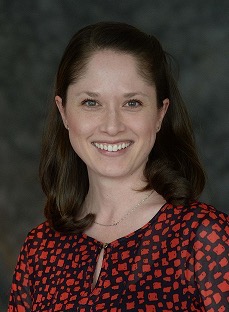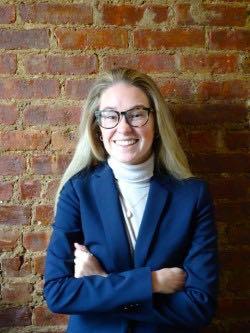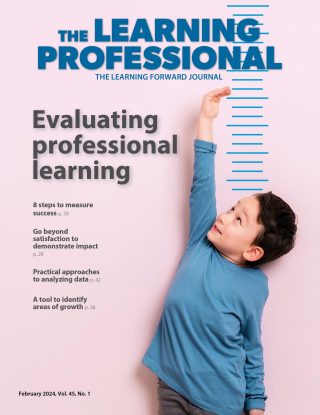IDEAS
Curriculum-based professional learning shows great promise
By Elizabeth M. Chu, Grace McCarty and Molly Gurny
Categories: Collaboration, Continuous improvement, Data, Evaluation & impact, Leadership, Research, ResourcesDecember 2022
Walk into a classroom in Seaford, Delaware, on a Tuesday afternoon, and you will find a room full of learners in deep discussion grounded in strong instructional materials. Pouring over content-rich texts or real-world math problems, these learners are engaging in close reading to identify textual evidence to support arguments and inferences, prompting one another to explore new mathematical strategies, and supporting each other to articulate next steps for their learning journeys.
What’s special about this Seaford class is that the desks are not filled with students. Rather, they are filled with teachers (both general education teachers and specialists who support students with disabilities) and leaders (including principals, assistant principals, and coaches) who come together regularly to engage in collaborative professional learning focused on how best to teach the curricula that are shared across the district.
Seaford’s teachers credit this professional learning as one of a set of instructional supports that expands their capacity to equitably serve a linguistically, racially, and socioeconomically diverse student body in ways that are rigorous, standards-aligned, and tailored to students’ specific needs. Moreover, the all-hands-on-deck nature of this professional learning has broken down barriers that too often exist between general education staff and special education providers, between individual schools within a district, and between educators and their leadership.
For many educators across the country, this practice of teachers deeply engaging with their content and the instructional materials they use in the classroom, testing strategies and collaborating with their peers, and practicing research-based approaches — known as curriculum-based professional learning — has become routine, the standard by which professional learning is defined (Short & Hirsh, 2022).
Curriculum-based professional learning is situated within the broader professional learning ecosystem. It focuses on how to teach a specific subject for specific grades, using the specific materials that teachers will use with their students. As explored in Jim Short and Stephanie Hirsh’s book, Transforming Teaching Through Curriculum-Based Professional Learning: The Elements, curriculum-based professional learning takes on various models (e.g. expert support, study groups, professional learning communities, institutes, workshops, and learning walks) and learning designs (e.g. inquiry-based and sense-making processes) to develop teachers’ beliefs, knowledge, and habits of practice (Short & Hirsh, 2022). The common thread across these varied approaches is the focus on accomplishing transformative learning through direct engagement with high-quality educative curriculum, which intentionally includes instruction and learning opportunities for teachers to support their use of the curriculum with students.
But for many, this practice is far from the professional learning they experience. In fact, a 2019 study highlighted that, on average, teachers received only one to two days of professional learning tailored to specific instructional materials, and a recent analysis by RAND Corporation indicates that roughly 23% of teachers reported receiving no professional learning on how to implement classroom materials, 38% just one to five hours, and only 10% more than 20 hours (Short & Hirsh, 2022; EdReports, 2022; Doan et al., 2021). Teachers report that the quality of the professional learning they receive is low, with half indicating that their preparation for teaching “did not prepare [them] at all” or only to a “slight extent” to use the curricular materials they were provided (Doan et al., 2021; EdReports, 2022).
An emerging field
Given the potential of curriculum-based professional learning to support teachers and strengthen educational experiences and outcomes for students, Columbia University’s Center for Public Research and Leadership recently conducted a study to explore the state of the field of curriculum-based professional learning and how it might grow to give all teachers the kinds of rich professional learning teachers in Seaford experienced (Chu et al., 2022).
The study asked and answered four research questions:
- Within the broader field of professional learning, how is the curriculum-based professional learning field defined, and what are its observable characteristics?
- Where is the curriculum-based professional learning field most developed, and what actions, conditions, and resources supported its development?
- Where is the curriculum-based professional learning field least developed, and for what reasons?
- To what extent does the curriculum-based professional learning field exhibit the key features and supports described in Short & Hirsh’s framework?
The Bridgespan Group, which provides a framework to understand field-building for population-level change, defines a field as a group of stakeholders from multiple settings working together, in coordinated and strategic ways, to achieve and sustain change at scale (Farnham et al., 2020). In this case, the field includes those who work inside and out of school buildings to improve teachers’ learning in service of students’ learning — teachers, leaders, district and state leaders, professional learning providers, philanthropies, and others.
To understand the state of the field, we conducted a systematic review of the literature on high-quality instructional materials, curriculum-based professional learning, and field-building. We interviewed 146 state-level academic leaders, regional leaders, system-level leaders, school-based professionals, professional learning providers, curriculum developers, philanthropic funders, and many others from across the country. To supplement these data, we sourced publicly available information about public and private giving to curriculum-based professional learning and related efforts and reviewed a number of secondary sources, including state professional learning websites, state-approved lists of professional learning providers, state professional learning standards, and Rivet Education’s Professional Learning Partner Guide (Rivet Education, n.d.). Finally, we reviewed publicly available information from RAND Corporation’s American Instructional Resources Survey for the last three years.
To analyze collected data, we employed The Bridgespan Group’s field-building framework and its five observable characteristics — field-level agenda, stakeholders, knowledge base, infrastructure, and resources — to understand the state of the curriculum-based professional learning field and assess its stage of development (Farnham et al., 2020). The Bridgespan Group theorizes three stages of field development: emerging, where impact is inconsistent; forming, where impact is more coordinated and consistent; or evolving and sustaining, where impact “accelerates exponentially, even as needs and conditions change” (Farnham et al., 2020).
Our research reveals that the field of curriculum-based professional learning is in its early, or emerging, stage. Yet this emerging field shows great promise. A diverse set of stakeholders — including funders, system- and state-level leaders, a growing number of professional learning providers, teachers and leaders, and many others — are aligned on a number of key approaches to promoting teacher effectiveness through curriculum-based professional learning. They agree that professional learning must be curriculum-based, contextualized, and grounded in cycles of improvement, and they engage in diverse work that advances curriculum-based professional learning, including building the research base for curriculum-based professional learning, establishing policies to increase the adoption and implementation of high-quality curriculum and curriculum-based professional learning, elevating examples of curriculum-based professional learning in action, and directly providing curriculum-based professional learning to systems and schools.
The infrastructure supporting these stakeholders is forming, with many linked through networks, associations, and shared knowledge and tools. Individually and collectively, stakeholders use a limited but growing knowledge base about curriculum-based professional learning to inform their practice, and they access limited but increasing public and private dollars to support implementation.
Next steps for scale
Moving from scattered implementation and impact to consistent and accelerating implementation and impact will require advancing the field of curriculum-based professional learning. Achieving this change at scale is work too big for any single organization.
Our research surfaced a set of recommendations about how to move the field from an early to middle stage, ensuring more teachers get the support they deserve. Our recommendations include:
- Engage those on the periphery. The field needs to engage more stakeholders who could shape its direction and expand its reach. This includes school leaders, teachers, students, families, educator preparation programs, professional associations, and regional service agencies.
- Leverage economies of scale. Some schools and districts that want access to curriculum-based professional learning can’t afford it, and some providers can’t afford to reach smaller districts. The field needs to explore delivery methods that enable districts to share resources.
- Prioritize quality. The field needs to strengthen and expand the evidence base for curriculum-based professional learning practices, testing practices and studying how they support impact, for whom, and under what circumstances. Then, they need to systematically and effectively execute those ideas.
Seeing these practices and the work of educators in Seaford as part of a broader movement can help move success stories like Seaford’s into the mainstream. For individuals and organizations engaged in curriculum-based professional learning, reimagining their work as part of a broader effort to further professionalize teaching and provide educators with robust adult learning experiences will strengthen efforts already underway. By working together in an increasingly coordinated and collaborative way, those who are working to scale curriculum-based professional learning will achieve something far greater than the sum of their individual efforts. They will co-construct a field — a movement — that gives teachers the learning opportunities they need to ensure students across the country have access to the consistently high-quality educational experiences they deserve.
References
Chu, E., McCarty, G., & Gurny, M. (2022). Curriculum-based professional learning: The state of the field. Center for Public Research and Leadership. cprl.law.columbia.edu/sites/default/files/content/CPRL-CBPL-Report-FINAL-0908.pdf
Doan, S., Fernandez, M.P., Grant, D., Kaufman, J.H., Setodji, C.M., Snoke, J., Strawn, M., & Young, C.J. (2021). American instructional resources surveys: 2021 technical documentation and survey results. RAND Corporation. doi.org/10.7249/RRA134-10
EdReports. (2022, May 25). State of the instructional materials market 2021: The availability and use of aligned materials. Author.
Farnham, L., Nothmann, E., Tamaki, Z., & Daniels, C. (2020). Field building for population-level change. The Bridgespan Group. bridgespan.org/insights/library/philanthropy/field-building-for-population-level-change
Rivet Education. (n.d.). Professional learning partner guide. plpartnerguide.org/
Short, J.B. & Hirsh, S. (2022). Transforming teaching through curriculum-based professional learning: The elements. Corwin.
Categories: Collaboration, Continuous improvement, Data, Evaluation & impact, Leadership, Research, Resources
Recent Issues
TAKING THE NEXT STEP
December 2023
Professional learning can open up new roles and challenges and help...
REACHING ALL LEARNERS
October 2023
Both special education and general education teachers need support to help...
THE TIME DILEMMA
August 2023
Prioritizing professional learning time is an investment in educators and...
ACCELERATING LEARNING
June 2023
Acceleration aims to ensure all students overcome learning gaps to do...














